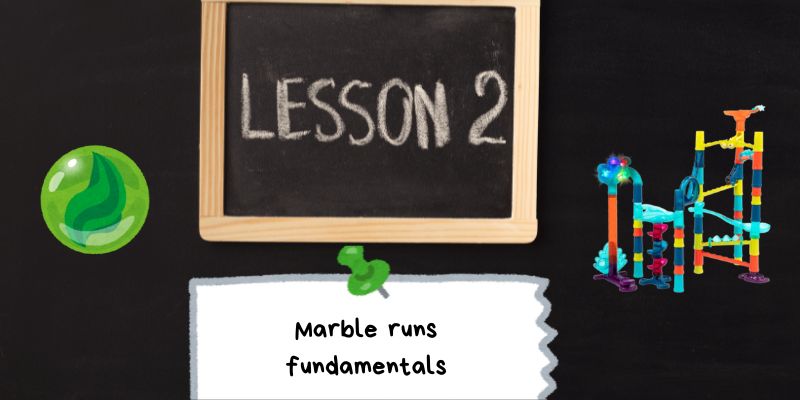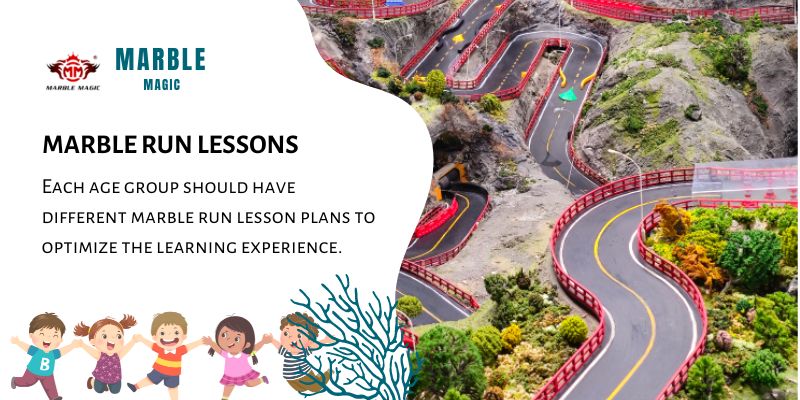Ready to take your classroom or homeschooling lessons to the next level? Marble run lesson plans are a fun and interactive way to teach science, technology, engineering, and math (STEM) concepts. They turn abstract ideas into tangible experiences, fostering a love of learning and discovery in students of all ages.
In this article, we will investigate the reasons why marble runs are valuable educational tools and offer creative lesson plans tailored to different grade levels. Whether you’re a teacher looking for hands-on activities or a parent seeking to engage your child’s curiosity, get ready to roll into the world of marble run learning!
Why should make a marble run lesson plans?
Integrating marble runs into your lesson plans might seem unconventional, but it’s a game-changer! These seemingly simple contraptions offer a treasure trove of educational benefits that can spark curiosity, ignite a passion for STEM, and make learning an unforgettable adventure. Here’s why you should consider incorporating marble run lesson plans into your teaching toolbox

Hands-On Engagement: Learning by Doing
Marble runs get students actively involved in the learning process. They’re not just reading about concepts; they’re building, experimenting, and observing firsthand how things work. This hands-on approach makes learning tangible, exciting, and memorable.
Multidisciplinary Learning: A STEM Powerhouse
Marble runs seamlessly integrate concepts from various STEM fields. Students explore gravity, momentum, friction, and energy transformation as marbles race down ramps and through loops. They design and build intricate tracks using various materials and tools, incorporating gears, pulleys, and other mechanisms.
Applying engineering principles to create sturdy structures, troubleshoot problems, and optimize track design for maximum efficiency becomes second nature. Math skills are honed by measuring distances, calculating angles, and analyzing data to understand the relationship between speed, time, and distance.
Differentiated Instruction: A Track for Every Learner
Marble run activities can be easily adapted to suit different ages and skill levels, making them an inclusive learning tool for all students. Younger learners can focus on basic concepts like counting, sorting, and color recognition. Elementary students can explore complex ideas like measurement, estimation, and simple machines. Older students can explore advanced physics concepts like velocity, acceleration, and energy conservation.
Promoting Critical Thinking and Problem-Solving
Marble run challenges encourage students to think outside the box, analyze problems, and develop creative solutions. As they encounter obstacles and unexpected outcomes, they must apply their knowledge and skills to find innovative ways to overcome challenges.
Fostering Collaboration and Communication
Building a marble run is often a collaborative effort. Students brainstorm ideas, design the track, and construct the structure. This collaborative process promotes teamwork, communication, and the ability to negotiate and compromise.
Making Learning Fun and Memorable
Perhaps the most compelling reason to use marble run lesson plans is the sheer joy and excitement they bring to the classroom. When learning is fun, students are likelier to retain information and develop a lifelong love of learning.
By incorporating marble run activities into your curriculum, you’re not just teaching STEM concepts; you’re fostering a love of learning, promoting creativity, and inspiring the next generation of scientists, engineers, and innovators.
Marble Run Lesson Plans for Different Grade Levels
Marble runs offer a unique and engaging way to teach STEM concepts to students of all ages. From preschoolers discovering gravity to high schoolers experimenting with complex mechanisms, these hands-on activities spark curiosity, creativity, and a love for learning. Here’s a breakdown of marble run lesson plans tailored to different grade levels

Preschool and Kindergarten (Ages 3-5): Exploring Basic Concepts
Focus: Sensory exploration, basic physics concepts like gravity and cause and effect, and fine motor skills development.
Activities: Build simple ramps with varying slopes to let children observe how the marbles’ speed changes, discussing concepts like “fast” and “slow.” Provide different colored or sized marbles for sorting and counting, introducing essential addition and subtraction. Encourage building simple structures with blocks to roll marbles through. Use sensory bins filled with rice, beans, or water beads to explore how marbles move through different textures.
Elementary School (Ages 6-10): Building and Experimenting
Focus: Introduction to the engineering design process, exploring simple machines like levers and pulleys, and measuring and comparing distance, speed, and time.
Activities: Design and build marble runs to meet specific criteria, such as the tallest or longest track. Organize “Marble Olympics” with challenges like the longest jump or fastest marble, recording the results. Incorporate simple machines like levers to launch marbles or pulleys to lift them. Use rulers, measuring tapes, and stopwatches to measure distance, speed, and time, creating graphs and charts to compare results. Experiment by changing variables like ramp angle, marble size, or track material to observe their effects on marble movement.
Middle School (Ages 11-13): Delving into Physics and Engineering
Focus: Understanding deeper physics principles such as gravity, friction, momentum, and energy conservation, and tackling more complex engineering challenges.
Activities: Design and build multi-level tracks with various obstacles and mechanisms. Calculate speed and acceleration using formulas and measurements on different track sections. Investigate the effects of friction on marble movement with different materials and surfaces. Collect data on marble speed, time, and distance using sensors or stopwatches, then analyze it to identify patterns and draw conclusions. Research and present on topics like famous marble runs, marble racing leagues, or the history of marbles.
High School (Ages 14-18): Applying Advanced Concepts
Focus: Applying physics principles to real-world engineering challenges, designing complex marble machines with automation and programming, and conducting independent research and experimentation.
Activities: Build marble runs that solve specific problems or meet certain criteria, such as sorting marbles by color or creating self-resetting tracks. Incorporate advanced mechanisms like gears, cams, and programmable components into marble machines. Conduct scientific inquiries to test hypotheses about marble run physics. Connect marble run concepts to real-world engineering challenges, such as designing transportation systems or structures. Research the history of marble games, the evolution of marble run technology, or the impact of marble racing on popular culture.
Marble runs transform abstract concepts into hands-on learning experiences that foster critical thinking, creativity, and a love for STEM. By integrating these activities into your lesson plans, you can make learning both fun and impactful for students of all ages.
Tips for Creating Engaging Marble Run Lessons
Marble runs are inherently fun and engaging, but with a bit of planning and creativity, you can transform them into powerful educational tools that captivate students and ignite a passion for STEM. Here’s how to create marble run lessons that are both educational and enjoyable

Set Clear Learning Objectives
Know Your Goals: Before starting, define the STEM concepts or skills you want your students to learn, such as understanding gravity, momentum, measurement, or data analysis.
Curriculum Alignment: Ensure your marble run activities align with your existing curriculum, creating a cohesive and meaningful learning experience that reinforces classroom instruction.
Tailor Activities to Age and Skill Level
Differentiate Instruction: Recognize that students learn at different paces and have varied backgrounds. Offer activities that cater to different skill levels, from simple tasks for beginners to complex challenges for advanced learners.
Scaffold Learning: Break down complex concepts into smaller, manageable steps. Provide guidance and support as needed while allowing students the freedom to explore and experiment.
Encourage Experimentation and Exploration
Open-Ended Challenges: Pose challenges that allow students to explore multiple solutions and discover their problem-solving approaches.
Variety of Materials: Provide diverse building materials like cardboard tubes, blocks, straws, and other recyclables, encouraging creativity and experimentation with different properties.
Guiding Questions: Instead of giving direct instructions, ask questions that prompt critical thinking and discovery through experimentation.
Foster Collaboration and Teamwork
Group Projects: Assign projects that require teamwork, promoting collaboration, communication, and idea sharing.
Divide and Conquer: Break down complex tasks into smaller parts, assigning them to different team members. This teaches the value of teamwork and division of labor.
Peer Learning: Encourage students to share knowledge, skills, and experiences, fostering peer learning.
Make it Fun and Interactive
Themed Challenges: Create challenges around exciting themes like space exploration, jungle adventures, or ancient civilizations to capture students’ interest.
Gamification: To make learning more engaging, incorporate game design elements, such as points, rewards, and competition.
Storytelling: Encourage students to create stories and narratives around their marble runs, bringing their creations to life.
Incorporate Technology: Use video recordings, digital simulations, or online tools to enhance the learning experience.
Connect to Real-World Applications
Relate to Careers: Discuss how concepts learned through marble runs are applied in real-world careers like engineering, architecture, and design.
Field Trips: Organize visits to science museums or amusement parks where students can see larger-scale marble runs in action.
Guest Speakers: Invite professionals like engineers or scientists to discuss how they use similar principles in their work.
By implementing these strategies, you can create engaging and effective marble run lesson plans that spark curiosity, foster a love of learning, and prepare students for future success in STEM fields.







